Cardinals created by Paul VI

Pope Paul VI (r. 1963–1978) created 143 cardinals in six consistories. His predecessor Pope John XXIII had disregarded the centuries-long tradition that limited the College of Cardinals to seventy members, increasing its size to as high as 88 in 1961[1] Paul continued this practice, and with his appointments the College grew to 103 in 1965, 118 in 1967, 134 in 1969. He then instituted a new rule that diminished the significance of the size of the College. In November 1970 he announced that as of 1 January 1971 only a cardinal who had not yet reached his 80th birthday would be allowed to enter a conclave.[2] When the 1973 consistory increased the size of the College to 145, the number of those under 80 who constituted the cardinal electors was 117. In 1975, he set the maximum number of cardinal electors at 120.[3] Each of his later consistories in 1976 and 1977 brought the number of electors to the full complement of 120.
Three of those Paul named a cardinal became pope, Pope John Paul I, Pope John Paul II, and Pope Benedict XVI.
22 February 1965
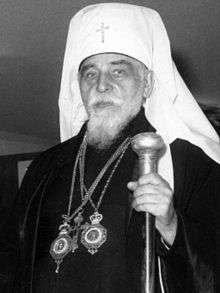
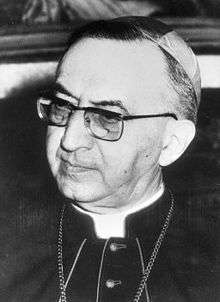
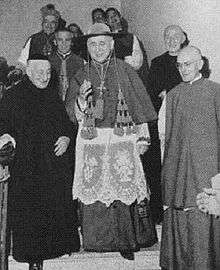
When Paul VI added members to the College for the first time, he increased its numbers from 76 to 103, raising the number of Italians from 26 to 32. The 27 he named included the first cardinal from Switzerland, the second black African, and three Eastern Rite Patriarchs.[4] He assigned the patriarchs to the College's highest rank, cardinal bishop, which was previously reserved to six cardinals assigned as bishops of sees near Rome.[5] He said that its growth did not suggest a lesser role for the world's bishops, but reflected the fact that "The proportions of the Church are no longer those of the 16th century".[6]
The ceremonies were reduced from four to two, though still scheduled to extend over four days.[7] At the second, public ceremony, the pope and the new cardinals concelebrated Mass for the first time on such an occasion and Paul, after addressing them briefly in Latin, spoke in Italian "because it is easier for us" and then several vernacular languages. The language of the rite was adapted slightly for the patriarchs and the new cardinals did not demonstrate obedience by prostrating themselves at the pope's feet.[8] Before the consistory, the Vatican restricted the use of silk in cardinals' attire.[9]
- Maximos IV Sayegh (1878–1967)
- Paul Peter Meouchi (1894–1975)
- Stéphanos I Sidarouss (1904–1987)
- Josyf Slipyj (1892–1984)
- Lorenz Jaeger (1892–1975)
- Thomas Cooray (1901–1988)
- Josef Beran (1888–1969)
- Maurice Roy (1905–1985)
- Joseph-Marie Martin (1891–1976)
- Owen McCann (1907–1994)
- Léon-Étienne Duval (1903–1996)
- Ermenegildo Florit (1901–1985)
- Franjo Šeper (1905–1981)
- John Heenan (1905–1975)
- Jean-Marie Villot (1905–1979)
- Paul Zoungrana (1917–2000)
- Lawrence Shehan (1898–1984)
- Enrico Dante (1884–1967)
- Cesare Zerba (1892–1973)
- Agnelo Rossi (1913–1995)
- Giovanni Colombo (1902–1992)
- William Conway (1913–1977)
- Ángel Herrera Oria (1886–1968)
- Federico Callori di Vignale (1890–1971)
- Josef-Léon Cardijn (1882–1967)
- Charles Journet (1891–1975)
- Giulio Bevilacqua (1881–1965)
26 June 1967
Pope Paul announced the names of 27 new cardinals on 29 May 1967, and the consistory that followed increased the College from 93 to 118 members, a new high. Twenty were European, including 12 Italians.[10][lower-alpha 1] He again simplified the cardinals' attire and reduced the number of their attendants,[13] but reorganized the ceremonies into three events.[14]
Some 24 of the 27 assembled in the Pius XII auditorium[lower-alpha 2] on 26 June and there received notes that Paul had named them in the closed ceremony. The other three, papal nuncios to Italy, Portugal, and Spain, followed the custom of receiving their notices and, later, their red birettas, from the head of the government to which they were posted.[15]
- Nicolás Fasolino (1887–1969)
- Antonio Riberi (1897–1967)
- Giuseppe Beltrami (1889–1973)
- Alfredo Pacini (1888–1967)
- Gabriel-Marie Garrone (1901–1994)
- Patrick O'Boyle (1896–1987)
- Egidio Vagnozzi (1906–1980)
- Maximilien de Furstenberg (1904–1988)
- Antonio Samorè (1905–1983)
- Francesco Carpino (1905–1993)
- José Clemente Maurer (1900–1990)
- Pietro Parente (1891–1986)
- Carlo Grano (1887–1976)
- Angelo Dell'Acqua (1903–1972)
- Dino Staffa (1906–1977)
- Pericle Felici (1911–1982)
- John Krol (1910–1996)
- Pierre Veuillot (1913–1968)
- John Cody (1907–1982)
- Corrado Ursi (1908–2003)
- Alfred Bengsch (1921–1979)
- Justinus Darmojuwono (1914–1994)
- Karol Wojtyła (1920–2005) (Pope John Paul II; 1978–2005)
- Michele Pellegrino (1903–1986)
- Alexandre Renard (1906–1983)
- Francis Brennan (1894–1968)
- Benno Gut (1897–1970)
28 April 1969

On 29 March 1969, Pope Paul announced he would increase the size of the College to 134 at a consistory on 28 April. He named 33 new cardinals from 19 countries, the largest group of new cardinals ever created at a consistory until then (later surpassed when John Paul II created 44 cardinals in 2001), and withheld the names of two more.[16][17] As part of three ceremonies, a new procedure required each to swear an oath of secrecy to "not divulge to their damage or discredit the councils entrusted to me, either directly or indirectly, without the consent of the Holy See".[18][lower-alpha 3] Of the two cardinals he created in pectore, the name of Štěpán Trochta was later published, but Iuliu Hossu of Rumania died in 1970 without being recognized as a cardinal, though Paul revealed his name at the 5 March 1973 consistory.
- Paul Yü Pin (1901–1978)
- Alfredo Scherer (1903–1996)
- Julio Rosales (1906–1983)
- Gordon Gray (1910–1993)
- Peter McKeefry (1899–1973)
- Miguel Darío Miranda y Gómez (1895–1986)
- Joseph Parecattil (1912–1987)
- John Francis Dearden (1907–1988)
- François Marty (1904–1994)
- Jérôme Rakotomalala (1914–1975)
- George Bernard Flahiff (1905–1989)
- Paul Gouyon (1910–2000)
- Mario Casariego y Acevedo (1909–1983)
- Vicente Enrique y Tarancón (1907–1994)
- Joseph Malula (1917–1989)
- Pablo Muñoz Vega (1903–1994)
- Antonio Poma (1910–1985)
- John Carberry (1904–1998)
- Terence Cooke (1921–1983)
- Stephen Kim Sou-hwan (1922–2009)
- Arturo Tabera Araoz (1903–1975)
- Eugênio Sales (1920–2012)
- Joseph Höffner (1906–1987)
- John Wright (1909–1979)
- Paolo Bertoli (1908–2001)
- Sebastiano Baggio (1913–1993)
- Silvio Oddi (1910–2001)
- Giuseppe Paupini (1907–1992)
- Giacomo Violardo (1898–1978)
- Johannes Willebrands (1909–2006)
- Mario Nasalli Rocca di Corneliano (1903–1988)
- Sergio Guerri (1905–1992)
- Jean Daniélou (1905–1974)
- Štěpán Trochta (1905–1974), in pectore, announced 5 March 1973
5 March 1973

On 2 February 1973, Pope Paul released the names of thirty new cardinals from 17 countries. The consistory on 5 March brought the number of cardinals to 145, with 117 young enough to serve as cardinal electors.[lower-alpha 4] The College had never been larger than 134 in April 1969.[20] The Vatican announced on 12 February that the ceremonies for creating cardinals would be simplied and shortened. Each cardinal's red hat would be delivered by messenger, not ceremoniously imposed by the pope.[21]
At the consistory on 5 March, a one-day ceremony that replaced a series spread across five days, Pope Paul revealed the names of two made cardinals in pectore in 1969: Stepan Trochta of Czechoslovakia and Iuliu Hossu of Rumania, the latter having died in 1970. He also discussed plans to modify procedures for papal elections, including limiting the number of electors to 120 and adding as voters the patriarchs of the Eastern Rite churches, even if not cardinals, and the leadership of the Synod of Bishops.[22]
- Albino Luciani (1912–1978) (Pope John Paul I; 1978)
- António Ribeiro (1928–1998)
- Sergio Pignedoli (1910–1980)
- James Knox (1914–1983)
- Luigi Raimondi (1912–1975)
- Umberto Mozzoni (1904–1983)
- Avelar Brandão Vilela (1912–1986)
- Joseph Cordeiro (1918–1994)
- Aníbal Muñoz Duque (1908–1987)
- Bolesław Kominek (1903–1974)
- Paul-Pierre Philippe (1905–1984)
- Pietro Palazzini (1912–2000)
- Luis Aponte Martínez (1920–2012)
- Raúl Francisco Primatesta (1919–2006)
- Salvatore Pappalardo (1918–2006)
- Ferdinando Giuseppe Antonelli (1896–1993)
- Marcelo González Martín (1918–2004)
- Louis-Jean Guyot (1907–1988)
- Ugo Poletti (1914–1997)
- Timothy Manning (1909–1989)
- Paul Yoshigoro Taguchi (1902–1978)
- Maurice Michael Otunga (1923–2003)
- José Salazar López (1910–1991)
- Émile Biayenda (1927–1977)
- Humberto Sousa Medeiros (1915–1983)
- Paulo Evaristo Arns (1921–2016)
- James Darcy Freeman (1907–1991)
- Narcís Jubany Arnau (1913–1996)
- Hermann Volk (1903–1988)
- Pio Taofinu'u (1923–2006)
24 May 1976
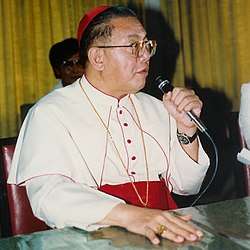
Pope Paul created 20 cardinals on 24 May 1976. That one of them was Trin Nhu Khue, Archbishop of Hanoi, was not announced until the ceremony and a 21st name was kept secret. The appointments brought the number of cardinal electors to 120 and number of cardinals to 137.[23][24] He had set the maximum number of electors at 120 in October 1975 in Romano Pontifici eligendo.[3]
- Octavio Beras Rojas (1906–1990)
- Opilio Rossi (1910–2004)
- Giuseppe Sensi (1907–2001)
- Juan Carlos Aramburu (1912–2004)
- Corrado Bafile (1903–2005)
- Hyacinthe Thiandoum (1921–2004)
- Emmanuel Nsubuga (1914–1991)
- Joseph Schröffer (1903–1983)
- Lawrence Picachy (1916–1992)
- Jaime Sin (1928–2005)
- William Wakefield Baum (1926–2015)
- Aloísio Lorscheider (1924–2007)
- Reginald Delargey (1914–1979)
- Eduardo Francisco Pironio (1920–1998)
- László Lékai (1910–1986)
- Basil Hume (1923–1999)
- Victor Razafimahatratra (1921–1993)
- František Tomášek (1899–1992), in pectore, announced 27 June 1977
- Dominic Ekandem (1917–1995)
- Trinh Nhu Khue (1898–1978)
- Bolesław Filipiak (1901–1978)
27 June 1977
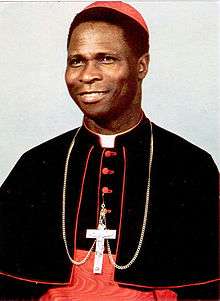
On 2 June 1977, Pope Paul announced that he would create four new cardinals on 27 June and made public the name of cardinal he had created in pectore a year earlier, Tomasek of Czechoslovakia.[25] All were young enough to serve as papal electors. This brought the membership of the College of Cardinals to 137[26] and the number of cardinal electors up to the limit of 120.[lower-alpha 5] By one account, this "mini-consistory"[27] was held principally for Benelli, who was being made Archbishop of Florence after ten years as Substitute at the Secretariat of State. Paul himself, at a similar stage of a similar career, had been appointed Archbishop of Milan in 1954 but not made a cardinal by Pius XII.[28] This treatment of Benelli prompted speculation that Paul was designating him his successor or preparing to retire when he reached 80 later in the year.[27][29]
- Giovanni Benelli (1921–1982)
- Bernardin Gantin (1922–2008)
- Joseph Ratzinger (b. 1927) (Pope Benedict XVI; r. 2005–2013)
- Mario Luigi Ciappi (1909–1996)
See also
Notes
- ↑ The number was expected to be 120, but Cardinal Joseph Ritter died on 10 June[11] and Cardinal Ernesto Ruffini died on 11 June.[12]
- ↑ Previously each new cardinal waited in a different location in Rome and messengers delivered their notice individually.[15]
- ↑ The new cardinals assembled in three locations outside the Vatican to be notified the pope had announced their names in the consistory.[19]
- ↑ When the consistory was announced, observers calculated 145 cardinals and 116 electors. Before the consistory, Cardinal Achille Lienart died at age 89. But the announcement of Cardinal Trochta added a cardinal elector.
- ↑ Since the 1976 consistory, three cardinal electors had died–Julius Döpfner on 24 July 1976, Émile Biayenda 23 March 1977, and William Conway on 17 April 1977–and two had celebrated their 80th birthdays–Ferdinando Antonelli on 14 July 1976 and Patrick O'Boyle on 18 July 1976.
References
- ↑ Cortesi, Arnoldo (17 January 1961). "4 New Cardinals Elevated in Rome" (PDF). New York Times. Retrieved 12 July 2018.
- ↑ Pope Paul VI (21 November 1970). "Ingravescentem aetatem" (in Latin). Libreria Editrice Vaticana. Retrieved 11 July 2018.
- 1 2 Pope Paul VI (1 October 1975). "Romano Pontifici Eligendo". Libreria Editrice Vaticana. Retrieved 11 July 2018.
- ↑ "Pope Designates 27 New Cardinals" (PDF). New York Times. 26 January 1965. Retrieved 26 October 2017.
- ↑ "Pontiff Installs 27 New Cardinals" (PDF). New York Times. 23 February 1965. Retrieved 26 October 2017.
- ↑ "Pontiff Assures Bishops on Role" (PDF). New York Times. 28 January 1965. Retrieved 26 October 2017.
- ↑ "Pope Cuts Down Ceremonies for the 27 New Cardinals" (PDF). New York Times. 13 February 1965. Retrieved 26 October 2017.
- ↑ "Pope Exhorts 26 New Cardinals to Share His Burdens" (PDF). New York Times. 26 February 1965. Retrieved 26 October 2017.
- ↑ "Cardinals' Garb Restricted Anew" (PDF). New York Times. 6 February 1965. Retrieved 26 October 2017.
- ↑ Fiske, Edward B. (30 May 1967). "Pontiff Appoints 27 New Cardinals" (PDF). New York Times. Retrieved 27 October 2017.
- ↑ "Pope Sends His Condolences to the St. Louis Archdiocese" (PDF). New York Times. 11 June 1967. Retrieved 27 October 2017.
- ↑ "Ernesto Cardinal Ruffini Dead; Archbishop of Palermo Was 79" (PDF). New York Times. 12 June 1967. Retrieved 27 October 2017.
- ↑ "Pope Simplifies Cardinals' Rites" (PDF). New York Times. 9 June 1967. Retrieved 27 October 2017.
- ↑ Fuske, Edward B. (29 June 1967). "Pontiff Presents Red Hats to 24 New Cardinals" (PDF). New York Times. Retrieved 27 October 2017.
- 1 2 "Pope Again Urges Jerusalem Step" (PDF). New York Times. 26 June 1967. Retrieved 27 October 2017.
- ↑ Doty, Robert C. (29 March 1969). "Pope Names 33 Cardinals; Cooke Among 4 From U.S." (PDF). New York Times. Retrieved 27 October 2017.
- ↑ "Names of the 33 Cardinals-Designate" (PDF). New York Times. 29 March 1969. Retrieved 27 October 2017.
- ↑ Doty, Robert C. (28 April 1969). "Cooke in Rome for Elevation to College of Cardinals" (PDF). New York Times. Retrieved 27 October 2017.
- ↑ Doty, Robert C. (29 April 1969). "Pope Forms Body to Define Heresy" (PDF). New York Times. Retrieved 27 October 2017.
- ↑ "30 Cardinals Named; Three Are American" (PDF). New York Times. 3 February 1973. Retrieved 26 October 2017.
- ↑ "Simplified Rites Are Set For 30 New Cardinals" (PDF). New York Times. 13 February 1973. Retrieved 26 October 2017.
- ↑ Hofmann, Paul (6 March 1973). "Pope, at Installation of Cardinals, Details Possible Reforms in Electing Successors" (PDF). New York Times. Retrieved 26 October 2017.
- ↑ "Archbishop of Hanoi Among 20 New Cardinals Installed by Pope". New York Times. 25 May 1976. Retrieved 26 October 2017.
- ↑ "Pope Paul Names 19 New Cardinals". New York Times. 28 April 1976. Retrieved 26 October 2017.
- ↑ Shuster, Alvin (3 June 1977). "Pope Names Top Aide a Cardinal, Making Him Potential Successor" (PDF). New York Times. Retrieved 26 October 2017.
- ↑ "Pope, Installing 5 as Cardinals, Again Warns Rebellious Prelate" (PDF). New York Times. 28 June 1977. Retrieved 26 October 2017.
- 1 2 Tornielli, Andrea (2013). Francis: Pope of a New World. Ignatius Press. Retrieved 6 December 2017.
- ↑ Pham, John-Peter (2004). Heirs of the Fisherman: Behind the Scenes of Papal Death and Succession. Oxford University Press. Retrieved 6 December 2017.
- ↑ Hadden, Briton; Robinson Luce, Henry. "Red Hat for the Right-Hand Man". Time. 109 (18–26). p. 361. Retrieved 6 December 2017.
External links
- Papal addresses to consistories, including names
- 22 February 1965 (in Latin)
- 26 June 1967 (in Italian; the Latin version includes the names of new cardinals)
- 28 April 1969 (in Italian; the Latin version includes the names of new cardinals)
- 5 March 1973 (in Italian)
- 24 May 1976 (in Italian)
- 27 June 1977 (in Italian)